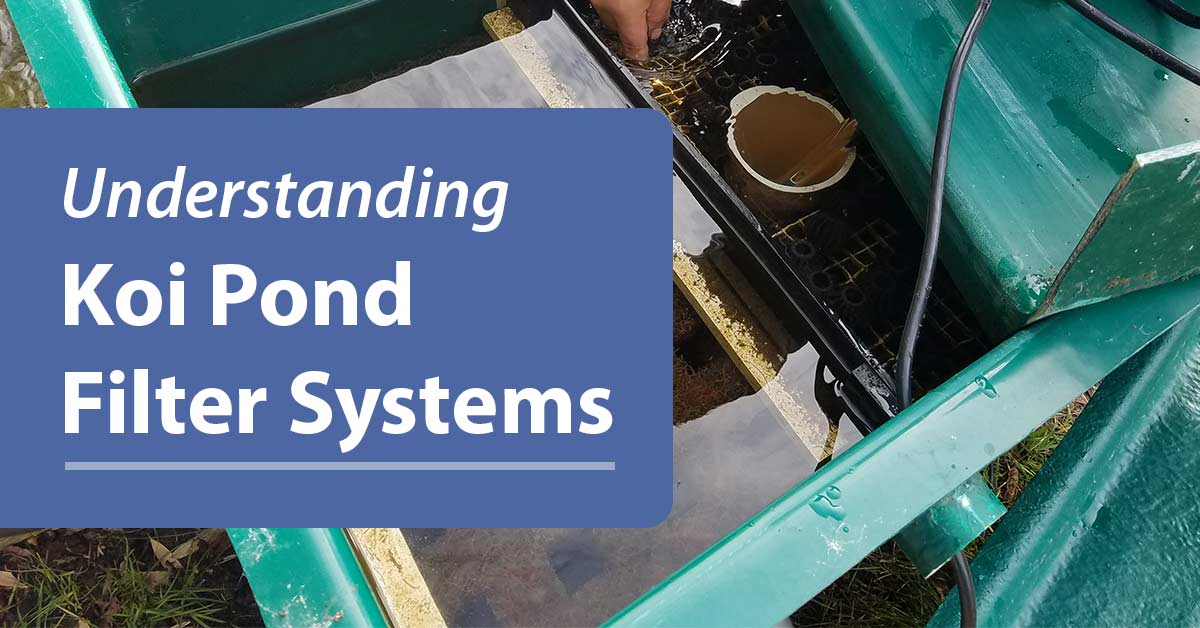
A filter is a critical part of a Koi pond. Why is it so important? Because for a koi, a pond without a filter is like living in a room with no toilet.
Table of Contents:
- Why do you need a filter for your Koi pond?
- Mechanical filtration vs. biological filtration
- Types of filter systems
- How to size your filter and more
Why do you need a filter for your Koi pond?
Koi spend the entirety of their lives in a pond; and they eat, sleep, and poop there. Imagine if you spent your entire life in 1 room. You would quickly have lots of trash and leftover food and—would need to go to bathroom.
If you put yourself in a Koi’s position, it is easy to understand why a filter is critical for a pond. However, I often see ponds with no filter. In many cases, hobbyists think they have a good-sized filter for their pond; but it turns out it is not big enough at all. Every Koi pond must have an appropriate filter system so that the Koi can live healthy and comfortably.
Mechanical filtration vs. biological filtration
In daily conversation, we just say “filter” or “filter system.” There are two main categories of filtration—mechanical and biological. It is important to understand the differences between the two.
In mechanical filtration, the filter physically separates and removes any wastes or solids. It is like a vacuum cleaner. If we go back to the example of living only in one room, once the room gets dirty with leftover food and waste, you would clean it with a vacuum cleaner. But the problem is that while physically removing waste makes the room appear clean, the waste still would leave behind polluted air in the room. In a Koi pond, the solids can be physically removed; and the water look crystal clear. But toxic substances like ammonia dissolved in the water will remain. This is why it is often said that clear water is not necessarily healthy water. Both solids and toxic substances must not only be visually removed, but also decomposed and purified.
This brings us to the second type of filtration—biological filtration. In biological filtration, we use help from bacteria. Beneficial (nitrifying) bacteria detoxify and purify the water.
Types of filter systems
There are many types of mechanical filtration. Sieve and RDF (Rotating Drum Filter) are very popular nowadays. They both use 200–300 micron-sized screens to filter water. Any small particles will be captured through this system, and you get crystal clear water. If you prefer an automatic system, RDF is a way to go.
A bead filter system is another one. This may be something you see more often. It looks like a pool filter. Bead filters come with backwash function so you can remove collected wastes from the system without getting your hands dirty. These filters also use small beads. They have a lot of surface areas for bacteria to grow on. So the system has some biological function, too. The Alpha One filter is one of the popular ones.
A biological filter system uses filter media materials to grow nitrifying bacteria. The main purpose of the media is not to filter particles, but to provide enough living space for bacteria to reside in. So it is important that media have ample surface area and do not clog. There are many type of filter media like filter mats, bio balls, brushes, and more.
- EvenFlow Bio-mats are very well designed. Collaborating with Musashino-giken Co. Ltd (manufacturer of Japanese filter mats), Mr. Mamoru Kodama, author of Kokugyo books, designed the mat to maximize the growth of bacteria and minimize clogging.
- Magnetic bio balls are also very effective. With patented technology, magnets are injected into the bio balls. These not only help bacteria growth, but also energizes the water.
There are many products that use these bio media.
- BioSteps Kit is ideal for water garden ponds up to 2000 gallons and koi ponds up to 1000 gallons.
- For progressive filtration try our BioSteps II Filter
Mechanical filters and biological filters both have their own purposes. If your pond is large, adding both types of filters is recommended so you can enjoy crystal clear water while knowing your water is healthy. If you have to pick only one for your Koi pond, please make sure to choose a biological filter system.
How to size your filter and more
It is highly recommended to double the size of your filter for your pond. In other words, if your pond is 1000 gallons, please install a filter that handles 2000 gallons. The size of your filter should ideally be based on the Koi population and how much waste they are expected to produce. But it is not easy to see the waste volume; so just go at least twice as big as your pond size. You can never oversize your filter.
Adding an air pump is also important. Nitrifying bacteria are aerobic bacteria. In other words, they need oxygen. So a lot of aeration in a pond is essential. (This is also why clogged media is bad. It stops the air supply to bacteria, and they die.) Even if you have a waterfall, in many cases, it is not enough. Adding an air pump, like a Medo Air Pump, is highly recommended.
I hope this blog is helpful to understand the basics of Koi pond filtration.
Happy Koi
Our Recommended Pond Filtration Products
These items help keep your koi’s environment clean and healthy so you can enjoy your koi pond for years to come. Thanks for reading.
AlphaOne Filter
AlphaOne pond filter provides less maintenance, increased flow, and less back pressure. We’ve heard of Koi enthusiasts running this filter for over month and still receiving crystal clear water. This is all possible because of it’s unique design to stop debris evenly throughout the pond, resulting in less maintenance, increased flow, and less back pressure.
EvenFlow Bio-Mat
We created the EvenFlow Bio-Mat to ensure the thousands of authentic Japanese Koi raised on our Kodama Koi Farm continue to live in perfect environments.
Magnet Bio Balls
Adding Magnet Bio Balls to your filter system increases oxygen, encourages good bacteria activity, and lowers the nitrite concentration. The Bio Ball diameter is 35mm and has 16 “wings” on its surface area, with a center hole. This makes it very porous and doubles the desired effect. Because the magnetic material is woven into the tempered plastic of the ball, you will find that this product can be used semi-permanently with no breakage or rust.
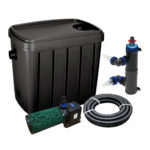
Biosteps Kit
Biosteps Kits maximize Matala® filter media performance. The rugged Biosteps 10 contains an amazing 200 sq. ft. of surface area for beneficial bacteria growth.
Combined with a cross flow design that traps and processes more debris at high flow rates, you get unparalleled mechanical and biological filtration for superior water quality.
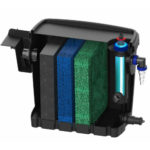
BioSteps ll Pond Filter
Ideal for water garden ponds up to 2000 gallons and koi ponds up to 1000 gallons.
You also have the option to “add on” the optional 16 watt EZClear UV Clarifier or the optional Waterfall Spillway at a later time if you decide to upgrade after you install the Matala BioSteps II Pond Filter on your pond.
Medo Air Pump
Medo’s unique and patent-awarded linear-motor driven free piston system is the key feature of this pump. As the piston is the only moving part, they run quieter, eliminates the wear components (which means “last longer”) and consumes only 50-60% of the typical diaphragm air pumps.
Further Reading About Koi
- Understanding Koi Clay From Japan
- Best Koi Food For Color
- Preparation Tips To Get Your Koi Pond Ready For Spring

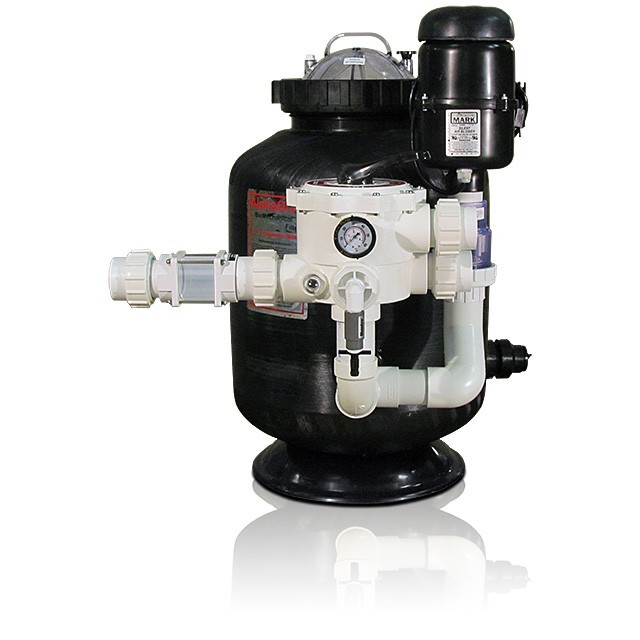
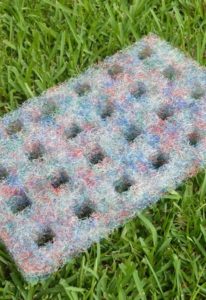
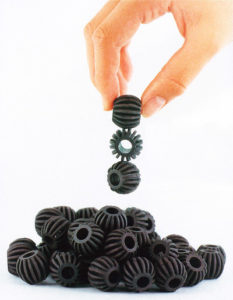
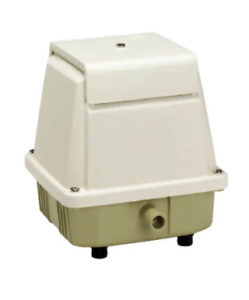
Can you recommend anyone in the Los Angeles area to install this great equipment ?
Miss Lerman,
Thank you very much for your comments. These products that I recommended here are all easy to install. I will email you direct with some questions.
So where does the koi poo go to? Doesn’t it clog up, rendering the bio part of the filter anaerobic?
Hello,
there is an aprea wheren they can settle. And once in a while, you need to open the valve to drain it out.
How often do I need to clean my bio-mats?
You can clean the mats only when they get too dirty and when you see your water quality going donw.
Happy Friday Taro, what filter is best for a 6000 gallon pond. Ronald
It is always a good idea to oversize at least double your filter capacity for your pond volume and Koi populations. There is no overkill as far as koi pond filter goes. For 6000 gal., maybe you can go with at least a combination of 1 bio Clean and 1 Alpha One 2.5. If you would like to talk more in detail, please email us at info@kodamakoifarm.com
You forget to mention here about using airlift pump. I prefer using airlift pump since it is free from mechanical maintenance and doesn’t clog, also safe from electrical shock accidents from submersible pumps
Yes, I agree with you. But airlift is more of another way of moving water, not really a type of filteration. So I did not mention it here. But airlift is always a great idea. Thank you for your comments.
You’re welcome, yes it is just a pump, yes, it is since it’s like hitting a bird in just one stone
Thanks for this article, Taro! I’m the proud owner of a new pond, looking forward to getting the right filtration system for koi.
You are very welcome. Good luck!
This article is extremely helpful! Thank you 🙂
I am glad it is helpful! Thank you for reading it
Hi, I would like to know. I have a pool size pond that I want to convert, do I need 2 pumps for the mechanical? One pump to pull from the pond and one pump to send the water back to the waterfall
Hi Harshad,
you do not really need two pumps. You need only one pump to feed your filter.
but please make sure you take water from the bottom (about 70%) and the surface (about 30%) to feed your filter
I am designing a pond that will be about 3000 gallons. I am trying to decide upon a filtration system. If I don’t have a waterfall am I still able to use the BioClean system?
Thank you for your comments. Yes, you can still use the Bio Clean system. If you have more questions, please give us an email at info@kodamakoifarm.com or simply call us at 808-354-7031
I have a 5x3x3 pond do I need a filter system? We have 2 fountains in the pond already?
If you have Koi fish in your pond, yes you do. Fountains are not good enough
Hello, I have a pond of 25000ltr capacity. Want to grow 1000 nos fish in this. Suggest me type of required pond pump and biofilter suitable for the above. Please suggest right products and pricing. I have a problem of algae formation currently
Hello, where are you located? Raising 1000 Koi in 25000 litters is quite a challenge, although it depends on the size of Koi.
I have a 80,000 gallon pond how do I keep it clean and clear cant find filters big enough
Mr. Leonard
Thank you very much for your comments. I will email you for some questions.
Our Koi Pond is 18 ft x 22 feet 20 inches deep we have a pump and a waterfall no other equipment. The water is very murky and I would like to resolve this without lots of equipment visible in the environment. What do you recommend?
I believe you need a proper filter and UV system. Please contact your local pond builder who can actually visit your pond
I have installed UV lights on my filter box, where the water passes from the pump on the pond. My Koi doesn’t seem to like it and they stay as far away from the waterfall coming out of the Filter Box (containers). Is there a limit on the use of UV lights? Is there a guide you can advise me on the use of UV Lights?
Hi,
So since you installed the UV, Koi has been away from the waterfall?
Did you do something to scare Koi like draining water all the way ?
UV is not fully exposed. Correct? Can Koi see the light?
Hello,
I have a 4500 gal pond with a dozen Koi’s. The water is too murky. I’d appreciate your suggestion on how to make the water clear. The system has a pump with a pressrurized bio filter and a UV light. I’m thinking of adding a mechanical filter (sand). Would it help? Should the sand filter be installed between the pump and the bio filter? Does it matter?
Hi Ben, thank you for the question.
First check if the circulation is good. If there is a dead area in your pond where water is not moving well, it affects the performance of your filter system. Also, I would like at least one turnaround per hour.
Is the filter big enough for 4500 gal pond. I usually double the capacity of filter. In other words, for 4500 gal. I would use 9000 gal. filter
please make sure if the filter is not clogged inside.
If the above is good and if water is still murky, then, you should add another filter, but not the sand filter. Sand filters do not work well for koi ponds. They can easily get clogged. Replace the sand with koi pond filter media to use it, please